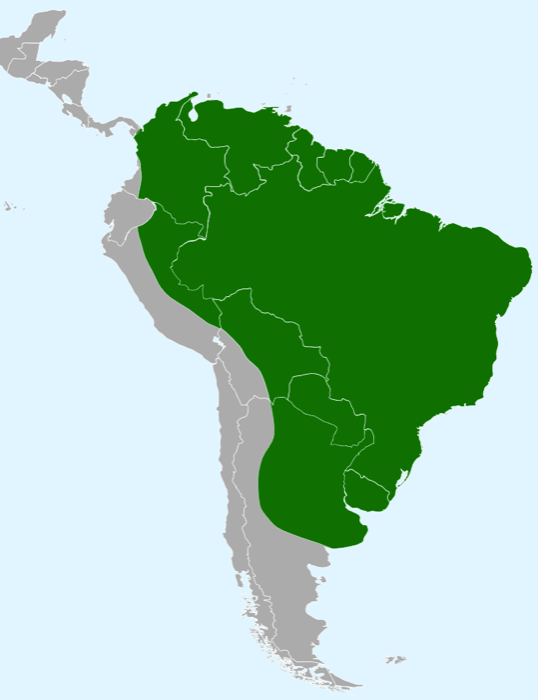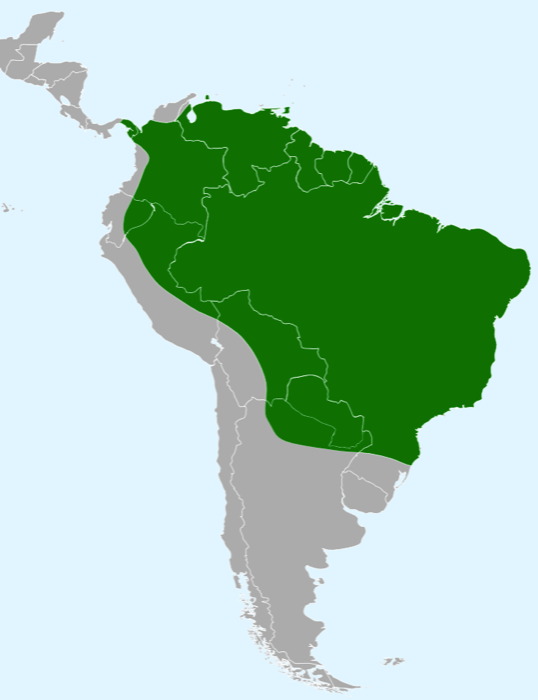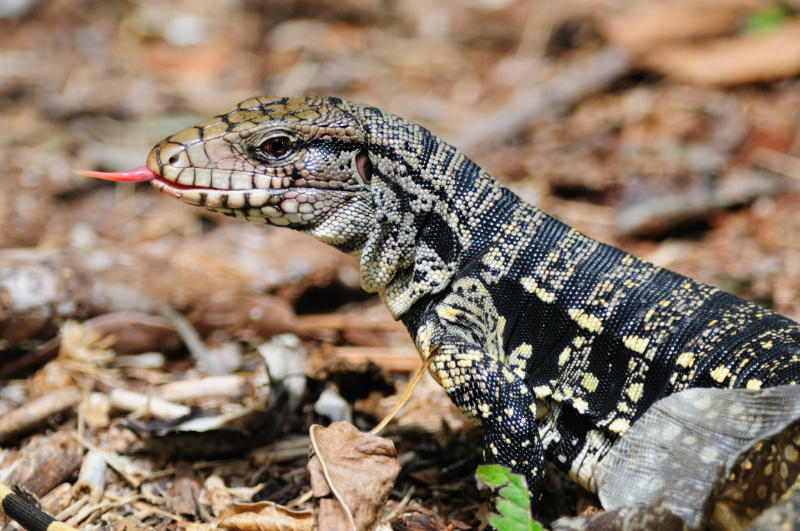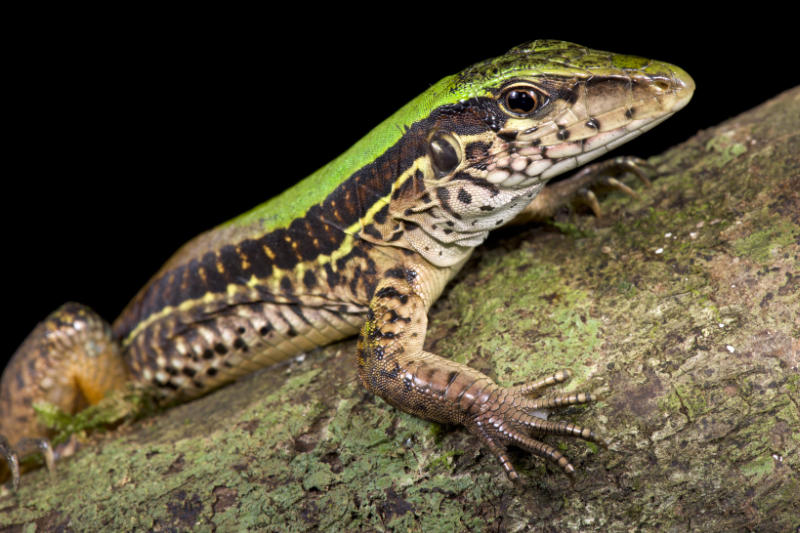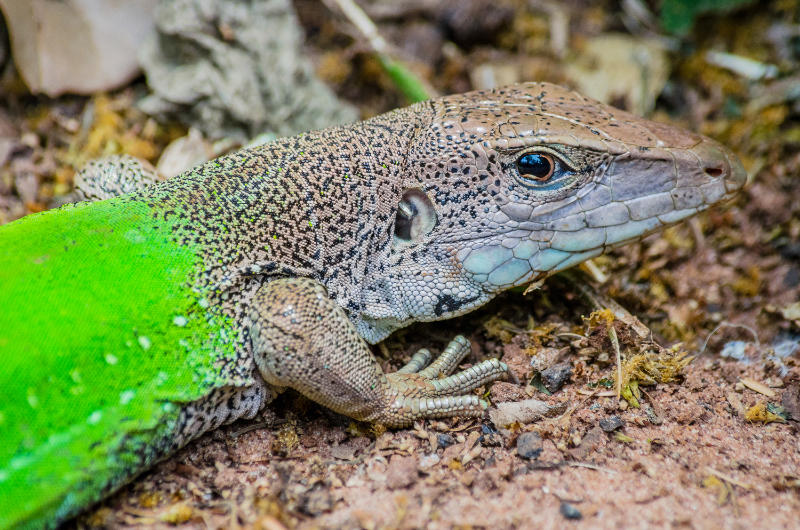Tegu
Tegu
The Tegu is another large lizard commonly seen within the Pantanal - and another favourite for the pet trade. Also within the same family are the Amazon Racerunners or Giant Ameiva.
Tegu
Tegus are similar in appearance to the monitor lizards of Africa and Australasia, and occupy much the same role - being primarily terrestrial, and an opportunistic predator of eggs, fruits, insect, small vertebrates or whatever else they can find. They have a long pointed head, solid muscular build, and especially powerful jaws. These jaws can exert pressure up to 1000N - which is sufficient for a bite to potentially crush human fingers. They have beaded skin and a pattern of repeating horizontal bands along the length of their body. They also have a long forked tongue which you can sometimes see them using to help find potential meal. Aside from size, the main distinction between the two species is their colour as indicated in their names - the Golden Tegu has yellow highlights instead of white. There is also a Red Tegu found in western Argentina and Paraguay, and a Blue Tegu which appears to be a rarer mutation of the Black and White Tegu. However, for their first few months, hatchlings will often appear emerald green.
Behaviour and Habitat
Although primarily terrestrial lizards, dictated by their large size and weight, tegus will sometimes climb small trees and rocks. They're also accomplished swimmers, able to remain submerged for around 20 minutes. When confronted, tegus will first try to flee, but can turn aggressive if cornered - delivering painful bites and sharp blows with their whip-like tail. By contrast, those born in captivity and kept as pets can be quite docile, intelligent, and even actively seeking out social interaction with their carers.
Scientific Name
Tupinambis teguixin or
Tupinambis merianae
Local Name
Teiú
Description
Large heavy-bodied lizard with long pointed head and muscular build. Beaded skin and a pattern of repeating horizontal bands.



Scientific Name
Ameiva Ameiva
Local Name
Calango Verde or
Bico-Doce
Description
Medium-sized lizard, about 40-50 cm in length. Head and shoulders are mottled grey, with bright green body.
The Tegu ranges across much of South America. In the northern part it's range the predominant species is the Golden Tegu (Tupinambis teguixin). The southern part of the range is predominantly the Black and White Tegu (Tupinambis merianae). The Pantanal region contains both species.
The Giant Ameiva (Ameiva Ameiva) ranges from Panama to northern Argentina. However, populations have expanded into Central America, with an introduced population also in Florida.
Reproduction
Conservation and Threats
Quick Facts
- When found in the wild, tegus will initially freeze motionless, with their head held up high. They will then make a sudden dash for escape.
- In parks and areas of human habitation, tegus feed on leftover scape of processed food, such as crackers, chips and cheese. However this causes health issues as their metabolism isn't able to cope with this diet.
- Tegus are among the most commercially exploited reptiles in the world. Up to a million are harvested annually in Argentina for their hide and meat - being a traditional source of protein and income in indigenous communities. Most of the animals are wild-caught.
- Tegu hides are popular in the US, where the leather is used for shoes and cowboy boots.
- Tegus are increasingly popular as pets. These were originally all wild-caught but there are now several breeders established in the US and Europe, supplying these markets with a range of different species.
Giant Ameiva
Behaviour and Habitat
Reproduction
There is no strict breeding season for ameiva, and it appears that this may be based on the specific environment in which they live. In some instances this may be year-round. However when mating occurs, the males mark their territory and protect it - as well as competing for access to females. The females appear to emit a pheromone which attracts and excite the males. Generally the large males have the most breeding success due to them being better able to intimidate and chase off smaller males. After mating, females only carry their eggs for a short period, and tend to stay in their burrows during this time. Once these eggs are laid (clutch size is 4-12), the incubation period lasts around 5 months. Within the Pantanal, hatchlings generally emerge at the beginning of the rainy season - which coincides with the period of peak food availability. Assuming the hatchlings can escape predation, their total lifespan is 3-4 years.
Conservation and Threats
Banner image: Low angle close up portrait of an adult Common Tegu Lizard (Shutterstock/Martin Mecnarowski)
